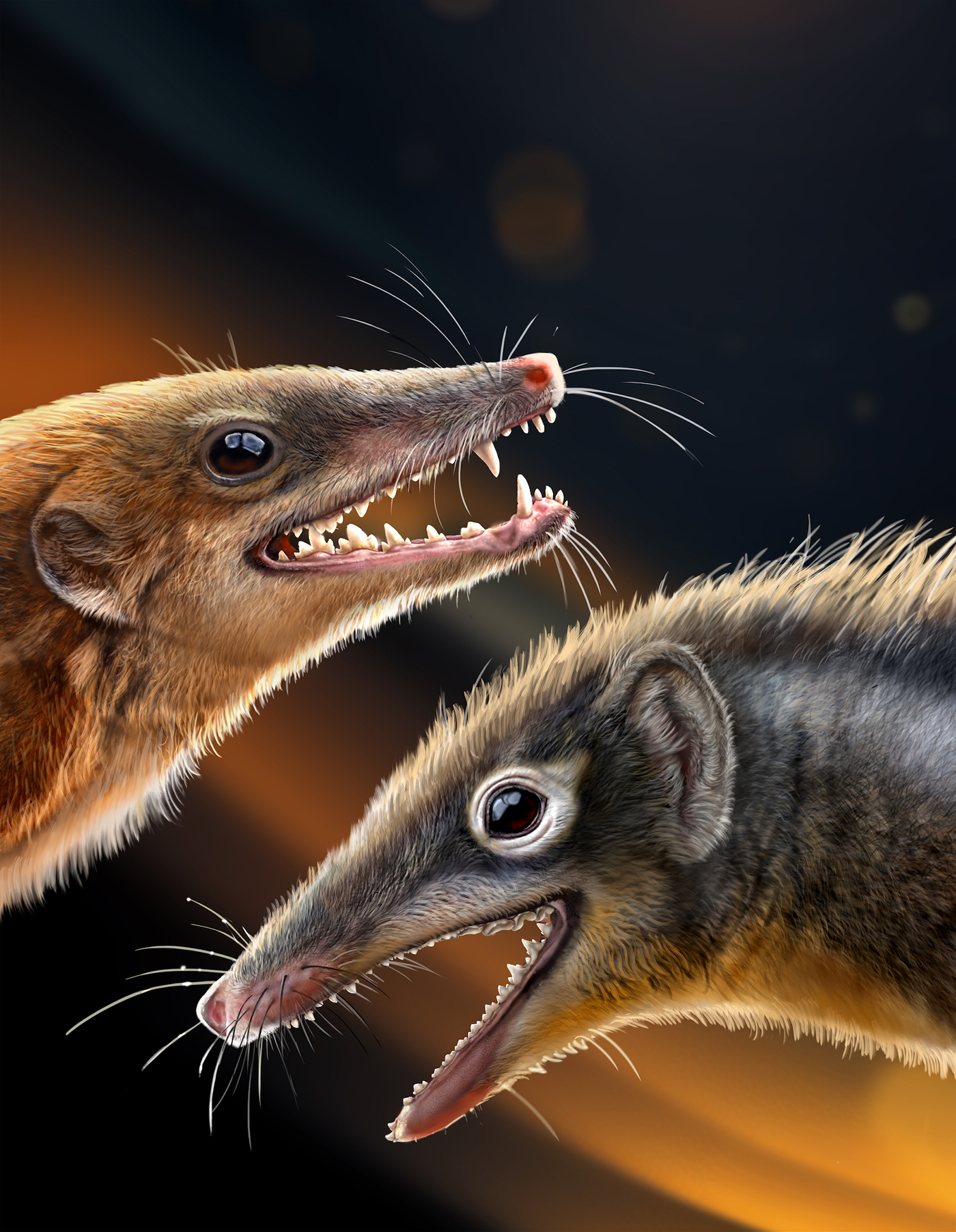The living mammal family tree is full of diverse species–big blue whales, great apes, bats, rodents, and humans, to name just a few. The early evolution of mammals is a little bit murky, with some placental mammals even likely living alongside dinosaurs and others arising much later.
Now, some teeth and ear bones uncovered in present day Inner Mongolia are offering some fresh insight into early mammalian evolution. The findings are described in two studies published April 3 in Nature that feature the work of scientists from the United States, Inner Mongolia, China, and Australia.
 Reconstruction of Feredocodon chowi (right) and Dianoconodon youngi (left). CREDIT: Chuang Zhao
Reconstruction of Feredocodon chowi (right) and Dianoconodon youngi (left). CREDIT: Chuang Zhao
Keeping up with the shuotheriids–and their teeth
In the first study, scientists focused on the shuotheriids. This family of mouse-sized mammals from the Jurassic period had molars that are different from those in any living mammal. Their molars had a pseudotalonid– or a basin-like structure in their lower molars more similar to reptiles. By comparison, living mammals have a tribosphenic pattern that interlocks with upper molars when chewing food.
“This unique tooth pattern has hindered our comprehension of shuotheriid relationships and the first steps in the evolution of mammaliaform species,” study co-author and Monash University paleontologist Patricia Vickers-Rich said in a statement.
With these unique back teeth, where these animals fit in the timeline of mammal evolution has been puzzling. Shuotheriids have previously been linked to a group called australosphenidans. This group includes living mammals that lay eggs like the platypus called monotremes. However, this relationship has been a bit controversial among scientists and leaves more questions that aren’t explained by some features seen in later mammals like different molars.
The team analyzed two newly uncovered and well-preserved skeletal fossils of shuotheriids. They lived in the Middle Jurassic between 168–164 million years ago in what is now Inner Mongolia. The team found that the molars of these animals were more similar to another extinct mammal group called the docodontans and not the australosphenidans. The two specimens also belong to a new genus and species named Feredocodon chowi.
[Related: A boiling hot supercontinent could kill all mammals in 250 million years.]
“When you look at the fossil record, both for mammals and many other sorts of animals, teeth are the part of the body that you are most likely to recover,” study co-author and curator in the American Museum of Natural History’s Division of Paleontology Jin Meng said in a statement. “Yet since the 1980s, the perplexing tooth shape seen in shuotheriids has been a barrier to our efforts to understand early mammal evolution. These new specimens have allowed us to solve this longstanding problem.”
The team believes that some common mammal ancestor independently gave rise to major groups of mammaliaforms: Docodontiformes, Allotheria, and Holotheria.
Listen up!
The second study focuses on the fossilized skulls of Feredocodon chowi and second new species named Dianoconodon youngi. It lived in the Early Jurassic between 201–184 million years ago. It was similar to an extinct rat-like animal called Morganucodon that is widely regarded as one of the first mammals.
 Reconstruction of the newly described species Dianoconodon youngi. CREDIT: Chuang Zhao
Reconstruction of the newly described species Dianoconodon youngi. CREDIT: Chuang Zhao
The team looked at the structure of Dianoconodon youngi’s middle ear, which helps give modern mammals their sharp hearing. In the middle ear, the spot inside the eardrum that turns vibrations in the air into ripples in the inner ear’s fluids has three bones. These bones called auditory ossicles are a feature that is unique to mammals and birds and reptiles only have one middle ear bone. At some point during the early evolution of mammals, the bones that formed the joints of the jaw separated and became associated with hearing.
[Related: A new evolutionary theory could explain the mystery of shrinking animals.]
Both Feredocodon chowi and Dianoconodon youngi specimens show some fossil evidence of this evolutionary transition in action, as mammals evolved from a group that includes lizards, crocodilians, and dinosaurs. The team believes that this transition began from an ancestral animal that had a double jaw joint. It likely had the joint of a mammal on the outside and a more reptilian joint on the inside.
Analyses on the older fossil (Dianoconodon youngi) show that one of its two joints, the reptilian one, was already beginning to lose its ability to handle the forces created by chewing. The younger fossil (Feredocodon chowi) had a more mammalian middle ear that was formed and adapted exclusively for hearing.
“Scientists have been trying to understand how the mammalian middle ear evolved since Darwin’s time,” said Meng. “While paleontological discoveries have helped reveal the process during the last a few decades, these new fossils bring to light a critical missing link and enrich our understanding of the gradual evolution of the mammalian middle ear.”

>>> Read full article>>>
Copyright for syndicated content belongs to the linked Source : Popular Science – https://www.popsci.com/science/mammals-evolution-missing-link/

















![[News] Japan Develops 10nm Nanoimprint Technology, with Potential to Tackle EUV Bottleneck – TrendForce](https://earth-news.info/wp-content/uploads/2025/12/329851-news-japan-develops-10nm-nanoimprint-technology-with-potential-to-tackle-euv-bottleneck-trendforce-360x180.jpg)













